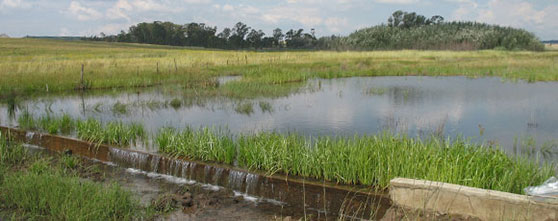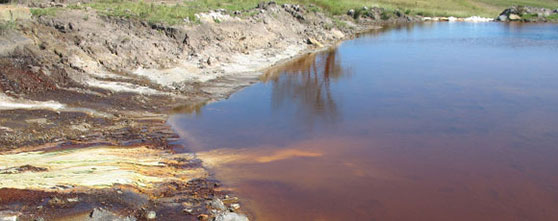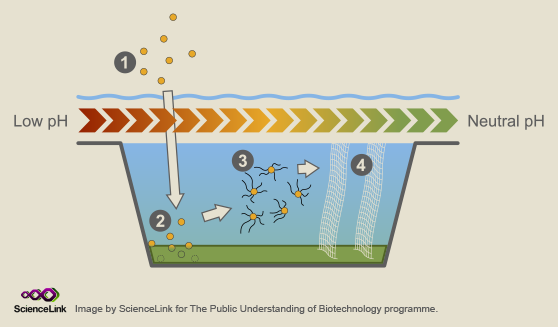|
Issue 3, February 2015

|
|
How crocodiles helped scientists in the fight against acid mine drainage

This constructed wetland is helping to improve water quality at an AMD-affected site in Mpumalanga. Image provided by Dr Paul Oberholster.
|
|
|
When crocodiles in Lake Loskop on the Olifants River started dying off in droves in the winter of 2008, baffled local authorities turned to scientists for an explanation. They were worried that what was poisoning the crocodiles would end up in the water supply of the Steve Tshwete District Municipality, downstream of Lake Loskop.
A bit of expert digging revealed that the crocodiles were dying of a condition called pansteatitis, or yellow fat disease. Usually caused by heavy metal accumulation (in this case mostly from aluminium and iron), pansteatitis turns fat reserves into a hard, rubber-like substance that cannot be metabolised.
Since they are no longer able to convert fat stores into food, crocodiles with the illness simply cannot generate enough energy to survive during the winter months.
How do these metals end up in the water? Mpumalanga is home to countless abandoned mines, and Lake Loskop is well-known repository for pollutants draining out of these, including sulphates and toxic metals. It is also these pollutants that contribute to the runaway acid mine drainage (AMD) problem in South Africa, particularly in the north.
Cheng, Botha and project leader Dr Paul Oberholster (CSIR) decided to investigate the accumulation of toxic metals in the Lake Loskop ecosystem. They traced the toxic metal poisoning backwards from crocodiles along the food chain to algae-eating fish, and then to algae.
In fact, they found that certain algae were accumulating such large quantities of toxic metals that it was killing the crocodiles at the top of the food chain. “That’s when we started thinking,” says Oberholster, “‘can we use these algae to treat AMD-contaminated water?’”
The type of algae they're interested in is easily-recognisable: it's the gloopy, filamentous stuff one sees filling stagnant ponds when everything else has died – usually green, orange or brown in colour. |
|
|
The current approach to treating acid mine drainage
According to Dr Po-Hsun Cheng (CSIR), acidic water (water with a low pH) is treated by adding lime, sodium bicarbonate, or even ammonium. This raises the pH of the water back up to neutral levels, but also leads to salts and metals precipitating as yellow-orange solids (this is known as ‘yellow boy’ formation).
Prof Anna-Maria Botha’s laboratory at Stellenbosch University tested some of this ‘neutralised’ water on human cells. Disturbingly, they found that the treated water was more toxic to human cells than untreated acidic water. This is likely because raising the pH of AMD-polluted water does not actually remove the metal contaminants. The implication is that the current approach to neutralise AMD-affected waters is failing to protect the South African environment and its people.
|
|
|
|

AMD-contaminated water seeps from a coal mine in Mpumalanga. Image provided by Dr Paul Oberholster.
It may be hard to believe, but this common gloop could be the answer to South Africa’s troubles with AMD: Cheng, Botha and Oberholster have spent the last two years evaluating several indigenous species of algae for their ability to thrive and accumulate metals in highly acidic water and at low temperatures. They collected the algae from AMD-contaminated dams and rivers to cultivate in the CSIR’s Natural Resources and the Environment laboratory.
The best candidates will be used as bioremediation agents. That is, they will be used in algal treatment ponds in combination with restorative wetlands to detoxify AMD-affected waters.
Dr Cheng explains the process: “We first coat special beads with algae which will grow to form an algal mat. Once the mat is saturated, the algae tend to break off naturally, ready to colonise nets placed in algal ponds. The idea is to create a kind of biofilm that can be used as a filter to clean the water.” |
|

The algal remediation scheme proposed by Dr Oberholster and colleagues. 1) Beads coated in algae are used to inoculate an artificial pond in an AMD-contaminated waterway. 2) Algae form a mat on the bottom of the pond. 3) When the pond floor is saturated, the algae will break off naturally and float downstream. 4) Nets will trap the algae and create algal biofilters to remove toxic metals. These nets can be easily removed and replaced when necessary. Image by ScienceLink.
|
|
It is an elegant, cheap and low-tech solution perfectly suited to the South African context, especially as it does not need a reliable power supply. It also requires no skilled labour, and maintenance of the systems is as simple as removing old nets and replacing them with fresh ones.
Perhaps best of all, it makes use of indigenous and non-genetically modified organisms, which means that implementation and uptake will be straightforward. “Everything about it is proudly South African,” says Cheng.
The obvious next question is whether this innovation is truly able to solve the AMD problem. Oberholster says that while it may not be the ultimate technology for AMD remediation, it is an affordable and feasible way to begin, and it has good potential in conjunction with other remediation strategies.
Testament to this is the Zaalklapspruit Wetland restoration scheme (a CSIR, SANBI and Coaltech 2020 collaboration aimed at finding ways of treating acid mine drainage from a coal-mining area upstream), where some of the algal species and water plants improved the water quality so much that naturally-occurring wetland plants and animals began moving in.
Within three months, the wetland water went from being as acidic as vinegar to being completely acid-free. In the same time period, aluminium levels dropped to below 5%. With this in mind, Oberholster envisions these artificial algal ponds forming one of the final stages of a restorative wetland approach to treat AMD-affected water.
Construction on an industrial-scale facility to grow the algae has begun at the CSIR in Pretoria, and the team is currently visiting mines to collect samples of waters that have proved difficult to remediate. Cheng is developing ‘cocktails’ of different algae to treat specific contaminants in these samples.
It is of course too late to save the Loskop Dam crocodiles, but as tragic as the loss of those majestic reptiles is, it has led scientists and South Africa to a potential remedy against AMD. And that may well save not just the lives of other wetland inhabitants, but the lives of South Africans living in AMD-affected areas.
Dr Paul Oberholster is a Chief Researcher at the CSIR’s Natural Resources and Environment group, and oversees several projects related to AMD treatment. Po-Hsun Cheng is a researcher at the CSIR’s Natural Resources and Environment group. Prof Anna-Maria Botha is a Professor at Stellenbosch University’s Department of Genetics. Read more about the work of Oberholster, Cheng and Botha here. |
|
|
 The PUB Programme is an initiative of the Department of Science and Technology and is implemented by SAASTA. The mandate of PUB is
to promote a clear, balanced understanding of the potential of biotechnology and to ensure broad public awareness, dialogue and
debate about biotechnology and its current and potential applications.
For more information visit www.pub.ac.za or contact
info@pub.ac.za, Tel: 012 392 9300 or Fax: 012 320 7803.
The PUB Programme is an initiative of the Department of Science and Technology and is implemented by SAASTA. The mandate of PUB is
to promote a clear, balanced understanding of the potential of biotechnology and to ensure broad public awareness, dialogue and
debate about biotechnology and its current and potential applications.
For more information visit www.pub.ac.za or contact
info@pub.ac.za, Tel: 012 392 9300 or Fax: 012 320 7803.
|
|
|

|
The articles in this newsletter have been reviewed by independent experts through SAASTA’s
Scientific Editorial Process. For more information please visit saasta.ac.za.
|
|
The PUB newsletter is an initiative of the Public Understanding of Biotechnology (PUB) programme.
The newsletter is developed by ScienceLink.
|
|
|
|
|
|